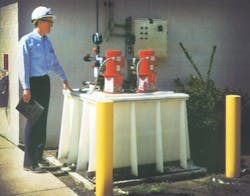Disposal System Avoids Soil & Groundwater Contamination
A chemical processing company has an onsite chemical laboratory that handles fluids such as acids, bases, standard oxidizing and reducing chemicals, and miscellaneous organic liquids. The lab had been experiencing severe environmental issues with its underground collection system, which is charged with handling, analyzing and disposing of small amounts of some 200 different raw materials, as well as 120 products made at the plant.
Utilizing Polypropylene
In order to solve its environmental problems, the company opted to install a complete wastewater collection and disposal system from Vanton Pump & Equipment Corp. This above-ground liquid waste disposal system is composed of corrosion-resistant polypropylene pumps that limit fluid contact to nonmetallic materials. Polypropylene, a thermoplastic, was chosen for its broad range of chemical compatibilities and because it eliminates any concern for corrosion or deterioration. The pumps are designed to isolate fluid from metal contact, limiting contact to only nonmetallic materials. The pump casing, impeller, pipe fittings and all wetted parts are made of polypropylene; the pump shaft is plastic sleeved to prevent corrosion.
This closed waste transfer system consists of four 200-gal polypropylene tanks, each positioned at one of the building’s outside corners. The tanks feature double-wall construction with a 2-in. gap between the walls that is tapped for leak detection. The Vanton system consists of two polypropylene sump pumps for each tank, as well as level controllers and control panels.
If any liquid enters the gaps, the probe senses it and triggers audible and visible alarms, permitting corrective action to be taken.
Inside the laboratory are two large sinks on each wall and two additional sinks in the center of the building that drain into a 39-gal tank under each sink. Two Flex-I-Liner self-priming peristaltic polypropylene pumps with flexible elastomeric liners then transfer the waste from these tanks to the outside tanks. Waste fluids from the corner tanks are blended with process waste and treated in an onsite bio-oxidation facility.
By using above-ground waste lines and limiting fluid contact to thermoplastic materials for the pumps and tanks, the company avoids the high-maintenance problems associated with metallic corrosion while protecting the environment by eliminating the chance of soil and groundwater contamination.
Download: Here
